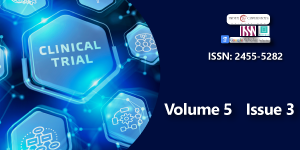Mass media information can facilitate early diagnose of hereditary angioedema: Case series study
Main Article Content
Abstract
Background: A patient’s motivation for consulting a physician is paramount to the first steps of achieving an early diagnosis of hereditary angioedema (HAE). Understanding what triggers this motivation can help in the design of strategies to increase the number of visits to a specialist physician following early symptoms of HAE. The aim of the present study was to identify the reasons that led patients to seek the opinion of an HAE expert physician.
Methods: The number of patients who had visited a specialist outpatient clinic for HAE was determined. All patients were asked what motivated them to seek medical consultation. Clinical data and blood samples were collected to establish a diagnosis.
Results: Seventy patients visited the clinic within a 30-month period between August 2015 and January 2018. Seven of these patients were diagnosed with HAE. The main source of evidence that prompted the visit to the specialist clinic was websites (67.1%), followed by newspapers (15.7%) and information provided by the home doctor (14.2%). The number of patients per month increased after a rise in the number of publications about HAE in newspapers and websites.
Conclusion: Mass media publications are an efficient way to motivate patients to visit an HAE expert physician.
Downloads
Article Details
Copyright (c) 2018 Ohsawa I, et al.

This work is licensed under a Creative Commons Attribution 4.0 International License.
Zuraw BL. (2008) Clinical practice. Hereditary angioedema. New Eng J Med 359: 1027-1036. Link: https://goo.gl/29heGT
Bowen T, Cicardi M, Farkas H, Bork K, Longhurst HJ, et al. (2010) 2010 International consensus algorithm for the diagnosis, therapy and management of hereditary angioedema. Allergy Asthma Clin Immunol 6: 24. Link: https://goo.gl/gjCndR
Asero R, Bavbek S, Blanca M, Blanca-Lopez N, Cortellini G, et al. (2013) Clinical management of patients with a history of urticaria/angioedema induced by multiple NSAIDs: an expert panel review. Int Arch Allergy Immunol 160: 126-133. Link: https://goo.gl/JfRovV
He S, Tsang S, North J, Chohan N, Sim RB, et al. (1996) Epitope mapping of C1 inhibitor autoantibodies from patients with acquired C1 inhibitor deficiency. J Immunol 156: 2009-2013. Link: https://goo.gl/3VwJcs
Cicardi M, Bisiani G, Cugno M, Spath P, Agostoni A. (1993) Autoimmune C1 inhibitor deficiency: report of eight patients. Am J Med 95: 169-175. Link: https://goo.gl/b6PBQ4
Casali P, Borzini P, Pioltelli P, Invernizzi F, Zanussi C (1978) Acquired C1-Inhibitor Deficiency in Essential Cryoglobulinemia and Macrocryoglobnlinemia. Acta haematol 59: 277-284. Link: https://goo.gl/qaFy7T
Ghannam A, Defendi F, Charignon D, Csopaki F, Favier B, et al. (2013) Contact system activation in patients with HAE and normal C1 Inhibitor function. Immunol Allergy Clinics 33: 513-533. Link: https://goo.gl/5ot3zN
Ohsawa I, Honda D, Nagamachi S, Hisada A, Shimamoto M, et al. (2015) Clinical manifestations, diagnosis, and treatment of hereditary angioedema: survey data from 94 physicians in Japan. Annals of Allergy, Asthma & Immunology 114: 492-498. Link: https://goo.gl/N9FicU
Ohsawa I, Honda D, Hisada A, Inoshita H, Onda-Tsueshita K, et al. (2018) Clinical Features of Hereditary and Mast Cell-mediated Angioedema Focusing on the Differential Diagnosis in Japanese Patients. Intern Med 57: 319-324. Link:
Agostoni A, Aygören-Pürsün E, Binkley KE, Blanch A, Bork K, et al. (2004) Hereditary and acquired angioedema: problems and progress: proceedings of the third C1 esterase inhibitor deficiency workshop and beyond. J Allergy Clin Immunol 114: S51-S131. Link: https://goo.gl/fJLwK5
Horiuchi T, Ohi H, Ohsawa I, Fujita T, Matsushita M, et al. (2012) Guideline for hereditary angioedema (HAE) 2010 by the Japanese Association for Complement Research - secondary publication. Allergol int 61: 559-562. Link: https://goo.gl/coc1EY
Yamamoto T, Horiuchi T, Miyahara H, Yoshizawa S, Maehara J, et al. (2012) Hereditary angioedema in Japan: genetic analysis of 13 unrelated cases. Am J Med Sci 343: 210-214. Link: https://goo.gl/JRLVcj
Maurer M, Magerl M, Ansotegui I, Aygoren-Pursun E, Betschel S, et al. (2018) The international WAO/EAACI guideline for the management of hereditary angioedema-The 2017 revision and update. Allergy 73: 1575-1596. Link: https://goo.gl/59oQwN
Honda D, Ohsawa I, Sato N, Inoshita H, Mano S, et al.(2017) Diminished capacity of opsonization and immune complex solubilization, and detection of anti-C1q antibodies in sera from patients with hereditary angioedema. Allergol Int 66: 603-609. Link: https://goo.gl/43dwbP

